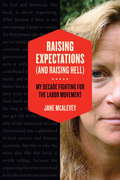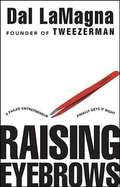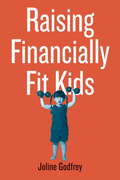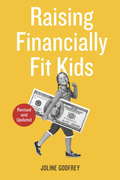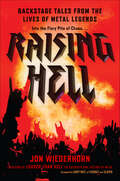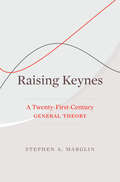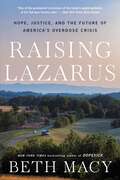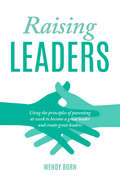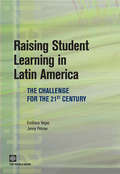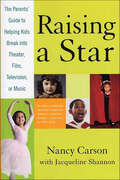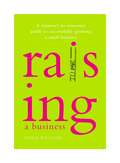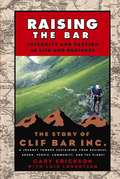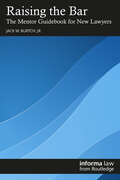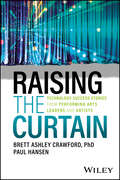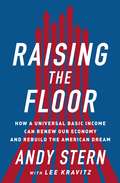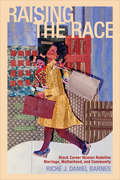- Table View
- List View
Raising Expectations (and Raising Hell)
by Bob Ostertag Jane McaleveyIn 1995, in the first contested election in the history ofthe AFL-CIO, John Sweeney won the presidency of the nation's largest laborfederation, promising renewal and resurgence. Today, less than 7 percent ofAmerican private-sector workers belong to a union, the lowest percentage sincethe beginning of the twentieth century, and public employee collectivebargaining has been dealt devastating blows in Wisconsin and elsewhere. Whathappened?Jane McAlevey is famous--and notorious--in the American labormovement as the hard-charging organizer who racked up a string of victories ata time when union leaders said winning wasn't possible. Then she was bouncedfrom the movement, a victim of the high-level internecine warfare that has tornapart organized labor. In this engrossing and funny narrative--that reflects thepersonality of its charismatic, wisecracking author--McAlevey tells the story ofa number of dramatic organizing and contract victories, and the unconventionalstrategies that helped achieve them. Raising Expectations (And Raising Hell)argues that labor can be revived, but only if the movement acknowledges itsmistakes and fully commits to deep organizing, participatory education, militancy,and an approach to workers and their communities that more resembles the campaignsof the 1930s--in short, social movement unionism that involves raising workers'expectations (while raising hell).
Raising Expectations for Bonsai Consumers: How Social Entrepreneurs Are Creating the Markets of the Future
by John Elkington Pamela Hartigan Roy D. ShapiroThis chapter examines how social entrepreneurs are partnering with the poor, helping empower growing numbers of bonsai (or BOP-bottom of the pyramid) consumers. The authors insist that these entrepreneurial projects are not alternatives to public and private sector action, but early indicators of the seismic market developments that are soon to come.
Raising Eyebrows
by Dal LamagnaThe often hilarious and sometimes poignant story behind Dal LaMagna's rise in the beauty industry.By the time LaMagna graduated from the Harvard Business School, his entrepreneurial activities--including operating discotheques in drive-in theaters, working with the 1960s musical teen sensations the Cowsills, and opening an ice cream parlor on the Venice Beach boardwalk--had landed him $150,000 of debt. Raising Eyebrows tells the story of how he finally succeeded.After years of failures and living pennilessly, LaMagna founded Tweezerman, one of the world's most respected, innovative and successful beauty tool manufacturers with over 40 million customers. A leader for socially responsible companies, Tweezerman became a success by making helping communities and caring for the environment everyday practices, not publicity gimmicks.A responsible capitalist, LaMagna wrote this roller-coaster memoir for entrepreneurs who are struggling and disenchanted with the ever changing economic systemPacked with business lessons, financial plans, and practical adviceRaising Eyebrows is full of inspiration, conscience, and good ideas for entrepreneurs and would-be entrepreneurs everywhere.
Raising Financially Fit Kids
by Joline Godfrey Kit HinrichsIs your child a spendthrift? A hoarder? Or maybe, downright oblivious? Are there family money dramas you can do without? In RAISING FINANCIALLY FIT KIDS, Joline Godfrey, one of the country's leading experts on kids, parents, and money, gives parents the secrets and knowledge she has gleaned from a decade of working with kids on financial literacy and business. At the heart of the book lies a defined set of values:Money is a tool for achieving and maintaining independence. Saving is good; accumulation for its own sake is not. Spending is best done wisely and within one's means (though a bold purchase or investment may also be an act of wisdom). Greed is not good. Giving generously is part of one's responsibility to the human family; shepherding wealth is an act of respect-to the past and the future. Money is an energy (not a commodity) that can be used for evil or for good.Designed for adults-parents, grandparents, mentors, advisors, and educators-concerned about raising children ages 5 to 18, RAISING FINANCIALLY FIT KIDS is centered around a developmental map covering ten specific money skills each child can master by the age of 18 to become a financially secure adult. This map gives parents a step-by-step approach to helping their kids become habitual savers, smart money mangers, and responsible decision makers. More than just a money book, RAISING FINANCIALLY FIT KIDS will help parents send their children into the world as balanced, financially stable individuals and contributing members of both their family and community.From the Trade Paperback edition.
Raising Financially Fit Kids, Revised
by Joline GodfreyThis combination parenting and personal finance book helps parents teach their children key money skills--such as saving, spending, budgeting, investing, building credit, and donating--that they'll need to become financially secure adults. Parents want their children to enjoy bright economic futures. But how do we equip the next generation with lifelong financial skills? In this updated edition of Raising Financially Fit Kids, Joline Godfrey shares knowledge gleaned from two decades of preparing children and families for financial independence and stewardship, philanthropic effectiveness, and meaningful economic lives. At the heart of the book are three big ideas:* Financial education is not just about the money; it's about building great families and raising self-confident kids who have the tools to realize their dreams.* Financial sustainability means living within one's means and acquiring skills to create and manage human and financial capital.* Giving wisely is a global citizen's responsibility.Designed for parents, grandparents, mentors, advisors, and educators, Raising Financially Fit Kids uses ten core money skills applied across five developmental life stages: children, tweens, middle schoolers, high schoolers, and twenty-somethings. Each stage includes age-appropriate activities that make financial fitness fun, from mall scavenger hunts to financial film festivals. In this global economic landscape, we all need financial fluency. Whether your child is five, fifteen, or twenty-five years old, it's never too late to teach financial literacy. Raising Financially Fit Kids prepares your children for the complexities of living in a global economy and helps your family up your game from good to great.
Raising Hell: Backstage Tales from the Lives of Metal Legends
by Jon WiederhornFrom the author of the celebrated classic Louder Than Hell comes an oral history of the badass Heavy Metal lifestyle—the debauchery, demolition, and headbanging dedication—featuring metalhead musicians from Black Sabbath and Judas Priest to Twisted Sister and Quiet Riot to Disturbed, Megadeth, Throwdown and more. In his song “You Can’t Kill Rock and Roll” Ozzy Osbourne sings, “Rock and roll is my religion and my law.” This is the mantra of the metal legends who populate Raising Hell—artists from Black Sabbath, Judas Priest, Slipknot, Slayer, and Lamb of God to Twisted Sister, Quiet Riot, Disturbed, Megadeth, and many more! It’s also the guiding principle for underground voices like Misery Index, Gorgoroth, Municipal Waste, and Throwdown. Through the decades, the metal scene has been populated by colorful individuals who have thwarted convention and lived by their own rules. For many, vice has been virtue, and the opportunity to record albums and tour has been an invitation to push boundaries and blow the lid off a Pandora’s box of riotous experiences: thievery, vandalism, hedonism, the occult, stage mishaps, mosh pit atrocities, and general insanity. To the figures in this book, metal is a means of banding together to stick a big middle finger to a society that had already decided they didn’t belong. Whether they were oddballs who didn’t fit in or angry kids from troubled backgrounds, metal gave them a sense of identity. Drawing from 150-plus first-hand interviews with vocalists, guitarists, bassists, keyboardists, and drummers, music journalist Jon Wiederhorn offers this collection of wild shenanigans from metal’s heaviest and most iconic acts—the parties, the tours, the mosh pits, the rage, the joy, the sex, the drugs . . . the heavy metal life! Horns up!
Raising Keynes: A Twenty-First-Century General Theory
by Stephen A. MarglinBack to the future: a heterodox economist rewrites Keynes’s General Theory of Employment, Interest, and Money to serve as the basis for a macroeconomics for the twenty-first century.John Maynard Keynes’s General Theory of Employment, Interest, and Money was the most influential economic idea of the twentieth century. But, argues Stephen Marglin, its radical implications were obscured by Keynes’s lack of the mathematical tools necessary to argue convincingly that the problem was the market itself, as distinct from myriad sources of friction around its margins.Marglin fills in the theoretical gaps, revealing the deeper meaning of the General Theory. Drawing on eight decades of discussion and debate since the General Theory was published, as well as on his own research, Marglin substantiates Keynes’s intuition that there is no mechanism within a capitalist economy that ensures full employment. Even if deregulating the economy could make it more like the textbook ideal of perfect competition, this would not address the problem that Keynes identified: the potential inadequacy of aggregate demand.Ordinary citizens have paid a steep price for the distortion of Keynes’s message. Fiscal policy has been relegated to emergencies like the Great Recession. Monetary policy has focused unduly on inflation. In both cases the underlying rationale is the false premise that in the long run at least the economy is self-regulating so that fiscal policy is unnecessary and inflation beyond a modest 2 percent serves no useful purpose.Fleshing out Keynes’s intuition that the problem is not the warts on the body of capitalism but capitalism itself, Raising Keynes provides the foundation for a twenty-first-century macroeconomics that can both respond to crises and guide long-run policy.
Raising Lazarus: Hope, Justice, and the Future of America's Overdose Crisis
by Beth MacyA &“deeply reported, deeply moving&” (Patrick Radden Keefe) account of everyday heroes fighting on the front lines of the overdose crisis, from the New York Times bestselling author of Dopesick (inspiration for the Peabody Award-winning Hulu limited series) and Factory Man. Nearly a decade into the second wave of America's overdose crisis, pharmaceutical companies have yet to answer for the harms they created. As pending court battles against opioid makers, distributors, and retailers drag on, addiction rates have soared to record-breaking levels during the COVID pandemic, illustrating the critical need for leadership, urgency, and change. Meanwhile, there is scant consensus between law enforcement and medical leaders, nor an understanding of how to truly scale the programs that are out there, working at the ragged edge of capacity and actually saving lives. Distilling this massive, unprecedented national health crisis down to its character-driven emotional core as only she can, Beth Macy takes us into the country&’s hardest hit places to witness the devastating personal costs that one-third of America's families are now being forced to shoulder. Here we meet the ordinary people fighting for the least of us with the fewest resources, from harm reductionists risking arrest to bring lifesaving care to the homeless and addicted to the activists and bereaved families pushing to hold Purdue and the Sackler family accountable. These heroes come from all walks of life; what they have in common is an up-close and personal understanding of addiction that refuses to stigmatize—and therefore abandon—people who use drugs, as big pharma execs and many politicians are all too ready to do. Like the treatment innovators she profiles, Beth Macy meets the opioid crisis where it is—not where we think it should be or wish it was. Bearing witness with clear eyes, intrepid curiosity, and unfailing empathy, she brings us the crucial next installment in the story of the defining disaster of our era, one that touches every single one of us, whether directly or indirectly. A complex story of public health, big pharma, dark money, politics, race, and class that is by turns harrowing and heartening, infuriating and inspiring, Raising Lazarus is a must-read for all Americans.
Raising Leaders: Using the principles of parenting at work to become a great leader and create great leaders
by Wendy BornLike parenting, leadership is difficult, challenging and rewarding - sometimes all in the first hour of the day! This enlightening new book explores the common principles of parenting and leading that will help you become a better leader and create great leaders in your team.You don't need to be a parent to be able to see the comparisons between raising children and creating next generation leaders (or indeed becoming a better leader yourself). We have all been raised by someone - if not a parent, another relative or carer - who traditionally shows the actions and considerations parents are known for. When you focus on observing the behaviour of leaders you admire, you will see similarities between them and your own experiences as a child or parent. Like parenting, leadership is difficult, challenging and rewarding - sometimes all in the first hour of the day. Whether parenting or leading you need to focus on five core areas to get the best out of your people:1.Love2.Environment3.Health and wellbeing4.Language5.Vision.Each of these core areas is discussed in detail through the book. Author, Wendy Born, uses a unique framework drawn from the principles of parenting that will help you to build and lead great teams. All you need is:Foresight to have a vision, strategy and purpose to guide your way into the future and manage your talent to fit.Plain sight to lead by example, establish boundaries and expectations creating a culture of accountability. Insight into the importance of a positive attitude and mindset, good work/life balance and establishing trust and connection as the foundation of your team. Packed with fascinating case studies and practical advice.
Raising Small Animals for Fun and Profit
by Paul VilliardFrom the Book jacket: Raising small animals can be, as everyone knows, a very absorbing hobby But few people know that it can also be profitable, either as a supplementary source of income or as a full- time business. And even fewer people know how to get started. In fact, almost anyone can raise and market small animals easily and with very little investment. A spare bedroom, an attic or basement, a screened-in sun porch, or a small outbuilding is an excellent location for the establishment of a "farm." Even an apartment dweller can have a small- animal business: in a few square feet you can raise many species of microscopic animals such as amoebas and hydras and sell them to laboratories and schools. With only a little more space, you can raise insects and worms for sale to pet stores as food for other animals, and other insects for sale to laboratories. You can start a tropical-fish business, in as large or small a space as you wish. You can raise mice, rats, hamsters, gerbils, and other small mammals in very little space. If you are lucky enough to have space in the country, you can raise show poultry and game birds or start a full-scale mink farm. But you have to know where to start, and how to determine what sort of business will suit the money and time you want to invest. That is why Raising Small Animals for Fun and Profit is an ideal introduction to this pleasant and practical occupation. From protozoa to mink, the book explains where to get breeding stock, how to raise and propagate the animals, where the market is. If you raise small animals, reading this book is important and throughout your venture, its suggestions and advice will save you much trouble. About the Author: Paul Villiard is a professional writer and photographer. He has written many other books about animals, including Reptiles as Pets, Exotic Fish as Pets, and Moths and How to Rear Them, and on other subjects, from nature photography to cabinetmaking. He also has from time to time been in the business of raising small animals; much of the information in Raising Small Animals for Fun and Profit comes directly from his own experience. Mr. Villiard and his family live in Saugerties, New York.
Raising Startup Capital
by Jeffrey J. Bussgangtypes of startup capital are equity funding and debt funding although there are a few hybrid flavors as well. Sources of funding. These include venture capital firms, angel investors, crowd-funding, and accelerators/incubators. What investors look for. Each source has a different funding process and set of criteria which you need to understand before seeking funding from that source. The mechanics of equity funding. Seeking and securing funding involves setting amounts, agreeing to terms, and defining relationships.
Raising Student Learning in Latin America: The Challenge for the 21st Century
by Emiliana Vegas Jenny PetrowUnderstanding what and how students learn has emerged as a salient issue in Latin America, a region where the majority of children now have access to schools but few students learn the skills they need to succeed. 'Raising Student Learning in Latin America' examines recent advances in our understanding of the policies and programs that affect student learning and provides policy makers with effective options.
Raising Your Risk Intelligence Systematically: Making More Informed Choices
by David ApgarOur risk intelligence directly affects the success of our plans and strategies. But the fit or gaps between our goals and risk skills is also a product of those plans and strategies. It's a major consequence of what we decide to do with our time and resources, and where and how we try to compete. Risk intelligence is not really an innate talent or intellectual aptitude--it is essentially a core competency that can be developed by individuals, teams, and organizations with ongoing observation, exploration, and learning. This chapter summarizes ten steps to employing risk intelligence in your decision making processes. This chapter is excerpted from "Risk Intelligence: Learning to Manage What We Don't Know."
Raising a Star: The Parent's Guide to Helping Kids Break into Theater, Film, Television, or Music
by Jacqueline Shannon Nancy CarsonSo your child wants to be a star? But what does it really take? Money? Looks? Tons of time? Not necessarily.Nancy Carson, a children's agent who has worked in the industry for more than twenty-five years and has guided the careers of such celebrities as Britney Spears, Mischa Barton, and even a young Cynthia Nixon, dishes the facts on what it takes to break your child into the entertainment industry. The first parents' guide to getting kids into the business written by one of the industry's top children's agents, Raising a Star is a complete step-by-step guide that will help parents navigate the murky waters of show business. From how to find the right representative to what producers and directors are really looking for in children today, Nancy Carson offers practical advice and anecdotes culled from her years of experience. Raising a Star is the most candid and informative guide for parents who want to help make their child a star.
Raising a business
by Sonia WilliamsRaising a Business is aimed at women who have recently started, or are planning to start, a business. It is designed to teach women how they can successfully prepare their business for, and manage, growth. It outlines the key areas that business owners need to look at to create a profitable, sustainable and successful business. The author, Sonia Williams, interviewed several successful Australian businesswomen, who share their strategies, tips and advice for growing a business.
Raising the Bar
by Gary Erickson Lois LorentzenIn April of 2000, Gary Erickson turned down a $120 million offer to buy his thriving company. Today, instead of taking it easy for the rest of his life and enjoying a luxurious retirement, he's working harder than ever. Why would any sane person pass up the financial opportunity of a lifetime?Raising the Bar tells the amazing story of Clif Bar's Gary Erickson and shows that some things are more important than money. Gary Erickson and coauthor Lois Lorentzen tell the unusual and inspiring story about following your passion, the freedom to create, sustaining a business over the long haul, and living responsibly in your community and on the earth. Raising the Bar chronicles Clif Bar's ascent from a homemade energy bar to a $100 million phenomenon with an estimated 35 million consumers, and a company hailed by Inc. magazine as one of the fastest-growing private companies in the U.S. four years in a row. The book is filled with compelling personal stories from Erickson's life-trekking in the Himalayan mountains, riding his bicycle over roadless European mountain passes, climbing in the Sierra Nevada range--as inspiration for his philosophy of business. Throughout the book, Erickson--a competitive cyclist, jazz musician, world traveler, mountain climber, wilderness guide, and entrepreneur--convinces us that sustaining one's employees, community, and environment is good business.If you are a manager, executive, business owner, or board member, Raising the Bar is your personal guide to corporate integrity. If you are a sports enthusiast, environmentalist, adventure lover, intrigued by a unique corporate culture, or just interested in a good story, Raising the Bar is for you.
Raising the Bar: Creating Value with the UN Global Compact
by Aron Cramer Claude Fussler Sebastian van der VegtThis book, produced by a unique team of business experts and UN agencies, is designed to fill a critical void-between the support of more than 1,000 organisations for the globally recognised Principles of the United Nations Global Compact and the need for this support to be translated into the day-to-day running of business to create value and improve performance. The ten Global Compact Principles cover human rights, labour standards, environmental responsibility and anti-corruption. But what does it mean to implement the Compact and its principles? How can the broad brush strokes of the Principles form the basis of management change? And how should companies establish benchmarks and performance indicators for implementation? For many companies, the journey is just starting. How can they ensure that they align with the Global Compact in ways that continue to reward their other business objectives? How should they embrace and capitalise on the Global Compact's potential for bringing together business, the public sector, trade unions and civil society in new partnerships? The aim of this book is to answer these questions by providing a performance model clearly grounded on the total quality management approach to assist businesses in putting the Global Compact into practice. Raising the Bar collects together and categorises a wealth of corporate responsibility tools, good practice and case studies in a structure familiar to anyone aware of business excellence models and demonstrates that values create value-leadership commitment to the Global Compact can impact both the boardroom and the shop floor, public image and balance sheet. Full of graphics and designed with accessibility in mind, the book will be a goldmine for managers looking for inspiration on how their businesses can be good corporate citizens and real proof that good business is also good for the bottom line.
Raising the Bar: The Mentor Guidebook for New Lawyers
by Jack W. Burtch, Jr.The effective mentoring of new associates used to be a natural part of the process for law firms, but nowadays economic pressures are inhibiting the practice; personal mentoring is being eliminated by the fiscal restraints of higher starting salaries and client insistence on fewer lawyers, and hands-on experience is hard to come by. Raising the Bar: The Mentor Guidebook for New Lawyers directly addresses this problem by creating one compact guide to relay the information necessary for success as a lawyer.This practical guidebook offers information, examples and anecdotal stories similar to the mentoring experience young lawyers used to enjoy in person. With its useful “takeaway tips” at the end of every chapter, Raising the Bar will help law students and new lawyers face the hidden challenges of practicing law. Beginning with career planning and the transition out of law school, the book’s 13 chapters cover topics ranging from mastering basic skills and dealing with clients to establishing trust and staying sane. It tackles delicate issues like fixing mistakes and surviving office politics. Finally, it closes with a discussion of other paths for those who decide to apply their legal education outside law practice.Written for new lawyers, law students, law firms and law schools, Raising the Bar offers, in a single book, what hours of close contact with experienced colleagues would provide a new lawyer when making the difficult transition from school to office.
Raising the Curtain: Technology Success Stories from Performing Arts Leaders and Artists
by Paul Hansen Brett Ashley CrawfordLearn how emerging technologies benefit artists and performing arts organizations Raising the Curtain: Technology Success Stories from Performing Arts Leaders and Artists focuses on empowering artists and performing arts organizations in theater, dance, and music to grow audiences and to increase impact through smart and strategic uses of technology. This book will help you effectively increase your artistic and administrative reach in order to expand your outreach to diverse audiences, without breaking the bank. In fact, you’ll be more efficient by choosing multi-function technologies that work for you. You’ll also see how advanced software can extend your donor reach—and ensure that you’re contacting donors at the right time. You can also maximize your organization’s brand by incorporating social media, AI tools, media streaming platforms, and more. Inside, you’ll learn about the most useful tech tools out there, including a wide breadth of technology, from Tessitura to A.I., from the success stories of artists such as Emmet Cohen and Jane Monheit, and organizations such as Attack Theatre and The Kennedy Center. Even more importantly, you’ll gain the confidence you need to incorporate technology into all areas of your organization in order to define your path to greater success. Discover software platforms, online tools, and other interactive technologies useful to designers, artists, and arts organizations Save money, expand your reach, and future-proof your performing arts organization or career Lead conversations about technologies and digital opportunities with staff, board members, or donors Get an overview of technology that addresses the unique opportunities and challenges facing the performing arts industry This book is a great resource for performing arts administrators and artists to learn new ideas about technology solutions. Administrators, leaders, and performers alike will appreciate the opportunity to bring art to audiences using today’s latest innovations.
Raising the Floor: How a Universal Basic Income Can Renew Our Economy and Rebuild the American Dream
by Andy Stern Lee Kravitzp.p1 {margin: 0.0px 0.0px 0.0px 0.0px; font: 12.0px 'Times New Roman'} p.p2 {margin: 0.0px 0.0px 0.0px 0.0px; font: 12.0px 'Times New Roman'; min-height: 15.0px} Raising the Floor confronts America's biggest economic challenge-the fundamental restructuring of the economy and the emerging disruptive technology that threaten secure jobs and income. Andy Stern convincingly shows why it is time to consider a universal basic income as the nation's twenty-first-century solution to increasing inequality. In 2010, troubled by watching families chase the now-elusive American Dream, Andy Stern began a five-year journey to investigate how technology will impact jobs and the future of work. Stern, formerly the head of the nation's most influential and fastest-growing union, the Service Employees International Union, investigated these issues with a wide range of CEOs, futurists, economists, workers, entrepreneurs, and investment bankers who are shaping the future.The sobering assessment that emerged from his research-across the political spectrum, from libertarians at the CATO Institute to the leaders of the progressive left-is that this time is different: there will be meager benefits that come with full-time work and fewer good jobs overall. Facing such a challenging moment, Stern's solution is fittingly bold: to establish a universal basic income by eliminating many current government programs and adding new resources. At once vivid, provocative, and pragmatic, Raising the Floor will spark a national conversation about creating the new American Dream.
Raising the Level of Abstraction
by Willy ShihThis technical note discuss abstraction as a way of generalizing a process or component for wider application. By hiding complexity inside a module, abstraction enables system designers o think at a higher level. This lower entry barriers to using (and reusing) a complex technology.
Raising the Race: Black Career Women Redefine Marriage, Motherhood, and Community
by Professor Riché J. BarnesPopular discussions of professional women often dwell on the conflicts faced by the woman who attempts to "have it all," raising children while climbing up the corporate ladder. Yet for all the articles and books written on this subject, there has been little work that focuses on the experience of African American professional women or asks how their perspectives on work-family balance might be unique. Raising the Race is the first scholarly book to examine how black, married career women juggle their relationships with their extended and nuclear families, the expectations of the black community, and their desires to raise healthy, independent children. Drawing from extensive interviews with twenty-three Atlanta-based professional women who left or modified careers as attorneys, physicians, executives, and administrators, anthropologist Riché J. Daniel Barnes found that their decisions were deeply rooted in an awareness of black women's historical struggles. Departing from the possessive individualistic discourse of "having it all," the women profiled here think beyond their own situation--considering ways their decisions might help the entire black community. Giving a voice to women whose perspectives have been underrepresented in debates about work-family balance, Barnes's profiles enable us to perceive these women as fully fledged individuals, each with her own concerns and priorities. Yet Barnes is also able to locate many common themes from these black women's experiences, and uses them to propose policy initiatives that would improve the work and family lives of all Americans.
Raising the Workers' Flag
by Stephen EndicottDuring the Great Depression, the conflicting interests of capital and labour became clearer than ever before. Radical Canadian workers, encouraged by the Red International of Labour Unions, responded by building the Workers' Unity League - an organization that greatly advanced the cause of unions in Canada, and boasted 40,000 members at its height. In Raising the Workers' Flag, the first full-length study of this robust group, Stephen L. Endicott brings its passionate efforts to light in memorable detail.Raising the Workers' Flag is based on newly available or previously untapped sources, including documents from the Royal Canadian Mounted Police's Security Service and the Communist Party's archives. Using these impressive finds, Endicott gives an intimate sense of the raging debates of the labour movement of the 1930s. A gripping account of the League's dreams and daring, Raising the Workers' Flag enlivens some of the most dramatic struggles of Canadian labour history.
Raj Kapoor: The Socialist Showman
by Geoffrey G. Jones Snigdha SurThis case examines the career of Raj Kapoor, the legendary Bollywood filmmaker of the postwar decades. It explores how Kapoor built RK studios after 1948 by releasing a series of movies that combined romance with social messages focused on the fate of the common man in a world of social injustice. The case discusses how women were depicted in Kapoor's films and enables a discussion of the role of cinema in propagating gender stereotypes and contributing to the challenges faced by women in rural India today. The case also explores the huge success of Kapoor's films in the Soviet Union and elsewhere in the Communist world. During the postwar decades there were two global worlds. In the Western world, Hollywood provided a stream of cinematic entertainment. In the Communist world, Bollywood provided the same service. They each provided alternative visions of the world.
